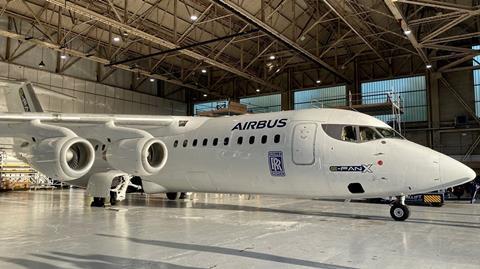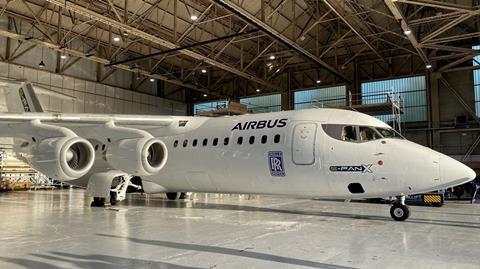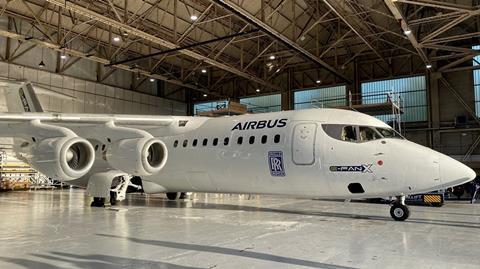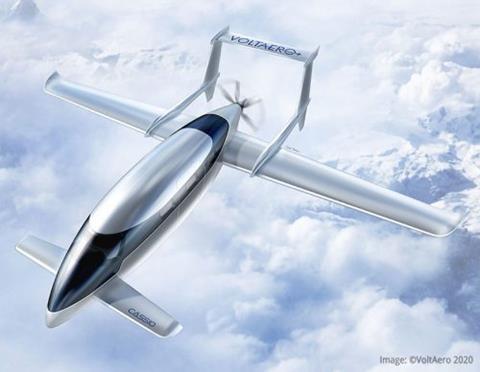Установить приложение
How to install the app on iOS
Follow along with the video below to see how to install our site as a web app on your home screen.
Примечание: This feature may not be available in some browsers.
Вы используете устаревший браузер. Этот и другие сайты могут отображаться в нем неправильно.
Необходимо обновить браузер или попробовать использовать другой.
Необходимо обновить браузер или попробовать использовать другой.
Электроавиация
Реклама
dunch
Старожил
По-моему, это какое-то новое слово в вопросах применения сверхпроводников - все одно охлаждать, так охладим уж до сверхпроводимостиОхлаждать электродвигатель нужно в любом случае. Вот и задумали охладить до температуры сверхпроводимости. А дальше как получится, так получится.
Сергей Гончаров
Старожил
Вообще-то - речь шла об ЭДАБ - электродвигательно-аккумуляторном блоке [в целом].Так а все ж таки зачем сверхпроводник в электродвигателе при его КПД без сверхпроводника?
Я действительно должен разъяснять преимущества АКБ на сверхпроводниках?
dunch
Старожил
не помешаетЯ действительно должен разъяснять преимущества АКБ на сверхпроводниках?
Просим, просим!Вообще-то - речь шла об ЭДАБ - электродвигательно-аккумуляторном блоке [в целом].
Я действительно должен разъяснять преимущества АКБ на сверхпроводниках?
Коллеги, не забывайте, что ВТСП - это керамика. Эти материалы хрупки и не поддаются сварке и другим видам соединения, т.е. всю сверхпроводящую цепь нужно отливать единовременно, причем именно в той пространственной конфигурации, в которой она должна работать.
Сергей Гончаров
Старожил
dunch, МиГ-31, Seerndv, По Вашим просьбам:не помешает
Преимущества АкБ на эффекте СП - следующие:
- радикально бОльшая уд. плотность энергии (и в пересчете на массу и в пересчете на объем)
- отсутствие электрических и тепловых потерь
- практически неограниченное число циклов "зарядка-разрядка"
- существенно более высокая скорость как запасания, так и отдачи э/э
- пожаробезопасность
dunch
Старожил
Сергей Гончаров,
Не совсем понятно, как пункт "пожаробезопасность" сочетается с "радикально большей емкостью". Казалось бы, параметры до некоторой степени в противофазе должны быть, нарушилась сверхпроводимость - и ка-а-а-ак шарахнет.
Погуглил. Такое впечатление, что сверхпроводниковые электродвигатели на самолетах - дело второй половины 21 века, а аккумуляторы - уже задел на подумать на 22 век.dunch, МиГ-31, Seerndv, По Вашим просьбам:
Преимущества АкБ на эффекте СП - следующие:
- радикально бОльшая уд. плотность энергии (и в пересчете на массу и в пересчете на объем)
- отсутствие электрических и тепловых потерь
- практически неограниченное число циклов "зарядка-разрядка"
- существенно более высокая скорость как запасания, так и отдачи э/э
- пожаробезопасность
Не совсем понятно, как пункт "пожаробезопасность" сочетается с "радикально большей емкостью". Казалось бы, параметры до некоторой степени в противофазе должны быть, нарушилась сверхпроводимость - и ка-а-а-ак шарахнет.
Seerndv
Старожил
- коронавирус и тут нагадил:
- исходник:
Европейцы закрыли проект демонстратора гибридного пассажирского самолета
Европейцы закрыли проект демонстратора гибридного пассажирского самолета

E-Fan X
Airbus
Европейский авиастроительный концерн Airbus и британская компания Rolls-Royce закрыли проект создания демонстратора гибридного пассажирского самолета E-Fan X. Об этом, как пишет Flightglobal, заявила главный директор по технологиям концерна Грация Виттадини. По ее словам, основной причиной закрытия проекта стала пандемия коронавирусной инфекции COVID-2019, сильно ударившая по авиастроительной отрасли и авиационным перевозкам.
Несмотря на закрытие проекта E-Fan X главный директор по технологиям Rolls-Royce Пол Стейн заявил, что компания продолжит испытания бортовых систем гибридного самолета и его двигательной установки. В частности, компания намерена полностью завершить разработку генератора и провести полный спектр его испытаний. Rolls-Royce также доведет до конца проекты систем температурного контроля и распределения энергии между бортовыми системами.
Проект E-Fan X стартовал в 2017 году. Проект предполагал переделку в гибридный демонстратор пассажирского самолета BAE Systems Avro RJ100 (BAe 146). На самолет предполагалось установить газотурбинный двигатель Rolls-Royce AE 2100, который бы вращал генератор мощностью два мегаватта. Этот генератор через системы управления и распределения энергии должны был заряжать бортовую аккумуляторную батарею и питать электровентилятор мощностью два мегаватта, установленный вместо третьего турбовентиляторного двигателя.
Электрический вентилятор планировалось собрать из электромотора компании Siemens, а также воздухозаборника и вентилятора двигателя AE 3700. Первый полет демонстратора гибридного самолета изначально планировался на 2020 год, но затем его перенесли на 2021-й. После первого этапа летных испытаний на E-Fan X электрическим вентилятором планировалось заменить второй двигатель. Все работы по переделке турбовентиляторного самолета в гибридный велись в ангаре аэропорта Крэнфилда в Великобритании.
В начале марта 2020 года Евросоюз дал старт программе разработки гибридного 50-местного пассажирского самолета для региональных перевозок, который может начать выполнять регулярные рейсы с 2035-2040 года. Первый этап проекта рассчитан на разработку технологий, которые могут быть использованы в перспективном самолете, а на также определение конфигураций летательного аппарата. Проект получил название Futprint50. Его головным разработчиком стал Штутгартский университет в Германии.
Василий Сычёв
- исходник:
Airbus and Rolls-Royce cancel E-Fan X hybrid-electric RJ100 experiment
By David Kaminski-Morrow24 April 2020
Airbus and Rolls-Royce have axed the E-Fan X demonstrator programme, a year before the experimental hybrid-electric engine airliner was supposed to fly.
The E-Fan X programme was launched to explore electric aviation and involved equipping a BAE Systems Avro RJ100 with a hybrid engine.
But Airbus chief technology officer Grazia Vittadini says that the airframer is having to “navigate the realities” of a world impacted by the coronavirus crisis, and concentrate on priorities.
She says Airbus and Rolls-Royce have “jointly decided”, as a result, to “bring the E-Fan X demonstrator to an end”.
“As with all ground-breaking [research] projects, it’s our duty to constantly evaluate and reprioritise them to ensure alignment with our ambitions,” adds Vittadini.
“These decisions are not always easy. But they’re undoubtedly necessary to stay the course.”

Source: Airbus
E-Fan X is being axed before the hybrid-electric RJ100’s maiden flight
She points out that the effort to decarbonise the aviation industry is “no small feat”, adding: “To achieve this, we need to re-focus all of our efforts on technology bricks that will take us there.”
The E-Fan X, launched in 2017, was due to carry out its maiden flight in 2021.
Vittadini insists that, while the aircraft will “not take to the skies”, the effort invested in the programme has not been wasted.
“To say we’ve learned a lot from this demonstrator project would be an understatement,” she says.
“Over the past three years, each successful E-Fan X milestone has offered us rich insights for the future.”
Vittadini says these include exploration of hybrid architecture, batteries and high-voltage systems, and new carbon dioxide reduction technologies, as well as certification and regulatory knowledge. She adds that Airbus has developed a “more focused roadmap” on progressing with decarbonisation.
“As with all such leading-edge programmes, we constantly evaluate the best way forward and it has become clear to both parties that the actual requirement to carry out a test flight with all the elements integrated is not critical at this time,” says Rolls-Royce chief technology officer Paul Stein.
He says the level of industry interest and support for the E-Fan X programme has been “particularly encouraging”.
“Although our programme with Airbus concludes, we are planning that our power-generation system ground testing will complete, allowing us to demonstrate the technology and capture all the lessons.”
Реклама
Seerndv
Старожил
Rolls-Royce to continue ground test of E-Fan X systems despite axing of programme
By Dominic Perry
25 April 2020
Rolls-Royce is to continue ground-test activities on the power generation system it was developing as its contribution to the Airbus E-Fan X, despite the programme’s cancellation before the hybrid-electric demonstrator ever flew.
Airbus and R-R on 24 April announced that they had pulled the plug on the project in order to “refocus” their efforts on bolder decarbonisation strategies.

Source: Airbus
Under the E-Fan X design, the partners intended to replace one of a BAE Systems Avro RJ100’s turbofan engines with an electric propulsion unit powered by an AE2100 turboshaft engine driving a 2MW generator mounted in the aft fuselage.
Modification activities were under way on the aircraft (G-WEFX) at Cranfield airport in the UK to support a first flight in 2021.
Despite the axing of the project, R-R plans to continue some development work as part of its drive towards more sustainable aviation.
“Although our programme with Airbus concludes, we are planning that our power-generation system ground testing will complete, allowing us to demonstrate the technology and capture all the lessons,” says R-R chief technology officer Paul Stein.
This will see the company integrate the generator, currently being tested at its site in Trondheim, Norway, with power-control and thermal-management systems developed by R-R’s units in Derby and Indianapolis, respectively.
“We will be going through a short period of re-planning due to this decision to make sure we properly capture all the lessons, knowledge and associated intellectual property,” he says.
Stein stresses that the decision to end the E-Fan X research was a joint one, adding: “As with all such leading-edge programmes, we constantly evaluate the best way forward and it has become clear to both parties that the actual requirement to carry out a test flight with all the elements integrated is not critical at this time.”
Any future hybrid-electric aircraft could still employ the systems developed for E-Fan X, says Stein, with a development effort to include “a comprehensive flight-test programme to ensure that all industry safety requirements are met.”
Seerndv
Старожил
И наконец третья часть марлезонского балета:
Why Rolls-Royce is still powering ahead with hybrid-electric development
Why Rolls-Royce is still powering ahead with hybrid-electric development
By Dominic Perry30 April 2020
When a demonstrator aircraft project is cancelled before it has a chance to take flight, there is inevitable speculation around the reasons for that move: ballooning costs, changing strategic priorities, or fundamental weakness of the technology on trial can all be causes for termination.
But Rolls-Royce maintains that, while cost considerations associated with flight testing were a factor in the unexpected axeing of the E-Fan X demonstrator it was jointly developing with Airbus, the hybrid-electric architecture it had designed has a bright – and clean – future.

Source: Airbus
A maiden sortie of the modified BAE Systems Avro RJ100 was due to take place next year, but the partners on 24 April announced they were pulling the plug, claiming that they had learned enough without the need to fly the aircraft.
Paul Stein, chief technology officer at Rolls-Royce, says that although a series of airborne trials was planned for the E-Fan X, a substantial amount of technology “de-risking” can take place on the ground.
Stressing that the cancellation was made “jointly”, Stein says the partners “felt that, particularly given the difficult times the aviation industry is about to go through, we had reached a point where we had learned what we needed to”.
While “taking it to flight-test would have been exciting” – and could have inspired the next generation of engineers – Stein says both parties were conscious of the expense involved.
“We just decided that taking it to flight-test at this point in the evolution of the technology was not worth the cost,” he says.
“Flight-testing would have cost tens of millions and we have both decided that we would prefer to save that money.”
Under the E-Fan X programme, the partners were to replace one of the RJ100’s four Honeywell turbofan engines with a 2MW electric motor. Rolls-Royce’s contribution comprised a 2.5MW generator powered by an AE2100 gas turbine engine, a 3,000V distribution system, plus new power control and thermal management systems.
Rolls-Royce is continuing to develop these individual parts and plans to ground-test the integrated system towards the end of the year at its Bristol site in the UK.
Stein refers to this distributed system as its “copper bird” – a nod to the ‘iron bird’ rigs used by airframers to test hydraulic and flight-control components in an aircraft-representative layout.
“By completing that ‘copper bird’ testing we feel we will be in a very strong position that as soon as the right conditions are in place – when an airframer starts to invest or a government goes for a moon-shot project to create a very early demonstrator of hybrid-electric flight – we are ready and ahead of the competition,” he says.
Stein emphasises that the E-Fan X was always intended as a demonstrator rather than a product in its own right and points to capabilities it has gained from the development.
“The thermal management is almost as much of a challenge as the electrics – it’s an area where we have gained an awful lot of knowledge,” he says.
While acknowledging that ground trials do not fully prepare the system for deployment, Stein is confident that these evaluations can sufficiently “de-bug” the technology to allow its incorporation in a future prototype.
Any points not covered by the ground-testing phase would not be “critical”, he argues, while the inability to build a sufficiently compact 2MW generator would be “a complete show-stopper”.
Although there have been suggestions that hydrogen power could play a significant part in the future, Stein does not see the technology arriving before the latter half of the 2030s.
Instead, hybrid-electric systems of around 3-5MW should be possible “by the end of this decade” for regional operations transporting up to 50 passengers on routes of 500-1,000nm (930-1,850km). Powered by sustainable aviation fuel, such a system would offer “compelling customer benefits” through reduced noise and emissions.
And while the technologies on the E-Fan X were aimed at the category of aircraft requiring 1MW of power and above, Stein sees rapid progress in electrification taking place lower down the weight range.
Hundreds of projects where kilowatts rather than megawatts of energy are required are currently in development, both for inter- and intra-city operations; Stein says Rolls-Royce is working with a number of start-ups “testing our various system components on their platforms”.
Additionally, the propulsion specialist is continuing to advance its Accel programme – an effort aimed at securing the speed record for an all-electric aircraft. The attempt on the record was due to have taken place this year, but social-distancing restrictions caused by the coronavirus pandemic have slowed progress. Ground-testing was due to begin just as the UK entered lockdown in late March.
The “class-leading” battery system, being developed with UK start-up Electroflight for Accel, “we very much see as a take-away” from what is otherwise a project with less of a sharp industrial focus, says Stein.
Rolls-Royce’s hope is that it will be the “battery and management system of choice for pure- and hybrid-electric aircraft designers”, he says.
Seerndv
Старожил
A220 operators advised to monitor compressor over stall risk
VoltAero reveals new configuration for hybrid-electric Cassio
By Dan Thisdell, Kate Sarsfield13 May 2020
A French bid to bring hybrid-electric propulsion to regional air transport from as early as 2022 has unveiled the production configuration of an aircraft family whose largest variant promises to carry 10 people over distances of around 650km (1,200km).
Revealed on 6 May, VoltAero’s Cassio will feature a single pusher prop, aft-mounted wing, high tail on a twin boom and canards.

Source: VoltAero
VoltAero Cassio
The configuration is radically different than the twin puller/single pusher prototype shown previously – including at the 2019 Paris air show – but will fly on the company’s proprietary hybrid drive system that began flight testing earlier this year.
For the current round of flight tests, operating from the company’s headquarters at Royan-Medis aerodrome on the Atlantic coast between Bordeaux and La Rochelle, a Cessna Skymaster is being progressively modified with VoltAero’s hybrid-electric propulsion system and battery packs.
Early flights feature two Safran-supplied ENGINeUS 45 electric motors and associated battery packs in puller mode added on the wings, with the Skymaster’s standard aft-mounted thermal engine contributing power; the Skymaster’s nose-mounted forward-facing thermal engine’s propeller has run shut down but feathered, available if needed. To date the demonstrator has logged 20h across 50 flights, says VoltAero.
In production configuration, the single pusher prop will be powered by an internal combustion engine – a Nissan petrol engine in original concepts – driving three 60kW electric motors. In standard operations, the electric motors would be used for relatively silent take-offs and landings with the engine extending range or available for direct drive of the propeller.
The hybrid drive system – able to deliver direct mechanical and/or or electric power to the propeller as flight conditions demand – is still in prototype stage and undergoing ground testing before integration on the aircraft.

Source: VoltAero
A Cessna Skymaster is being progressively modified with VoltAero’s hybrid-electric propulsion system
VoltAero’s concept is modular, and the company plans to offer three variants. First to market in late 2022 is the four-seat Cassio 330 featuring a 330kW drive system. The six-seat 480kW Cassio 480 and 10-seat 600kW Cassio 600 are scheduled to enter service in 2023 and 2024 respectively, says VoltAero.
Jean Botti, the former Airbus chief technical officer, founded the company with Didier Esteyne - a close collaborator at Airbus during development and testing of the E-Fan all-electric two-seater which made the first all-electric Channel crossing in 2015. The project, says Botti, “benefits from our team’s unmatched experience in hybrid-electric aviation”.
VoltAero promises a 200kt (370km/h) cruise speed and 3h 30min endurance, extendable to 5h. Take-off and landing distance is projected to be less than 550m (1,800ft) and maximum take-off weight will be below 2.5t to comply with European Union Aviation Safety Agency CS-23 certification requirements.
The all-composite Cassio family will be produced on a purpose-built final assembly line in the Nouvelle Aquitaine region of southwest France. VoltAero says it will also seek partners for licensed production in North America and Asia.
Вчера впервые взлетел MagniX eCaravan, разрабатываемый для коротких пассажирских рейсов. Пока что он способен взять на борт 5 пассажиров, но к моменту сертификации (конец следующего года) предполагается перейти на батареи нового поколения, с которыми пассажировместимость возрастет до проектной (9). Система управления электродвигателем изначально рассчитана на гибкий переход между разными источниками электроэнергии и с целью резервирования выполнена четырехпоточной. По сравнению с изначальной турбиной резко снизился уровень шума - от летящего рядом самолета сопровождения Cessna 182 (с которого сделано фото) в кабине больше шума, чем от собственной силовой установки. Подробнее здесь (англ.).

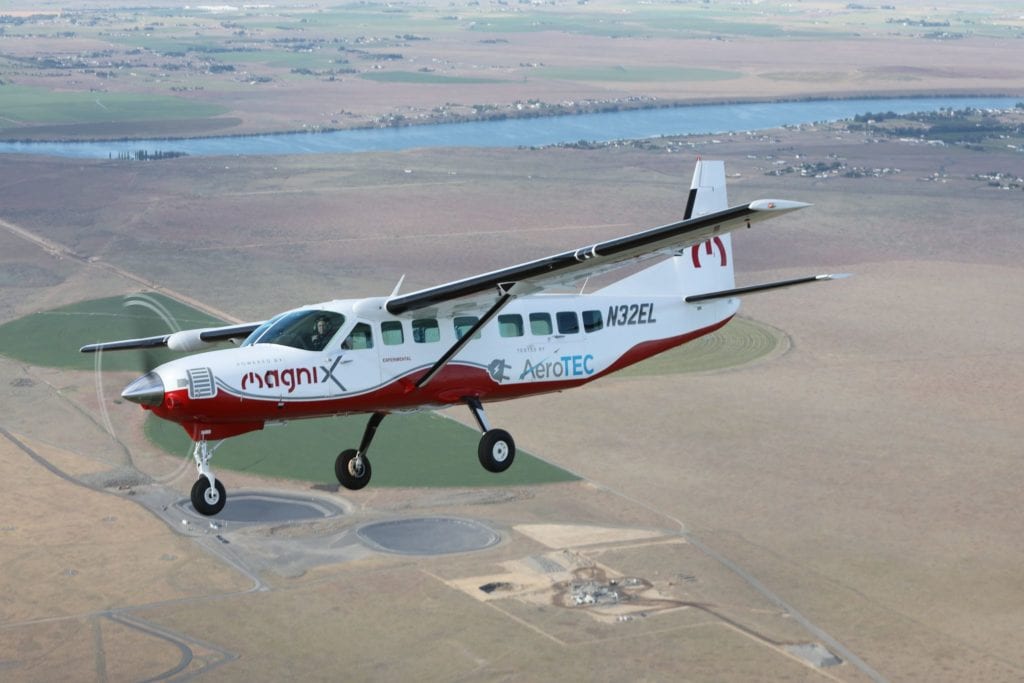
Видео здесь.

 www.bbc.com
www.bbc.com

World's largest all-electric plane takes flight
An historic day for the aviation industry as the world's largest all-electric plane takes flight.
И центровка не меняется по мере выработки.
Бесценно!
Бесценно!
Seerndv
Старожил
EASA Awards First Electric Aircraft TC to Pipistrel
EASA Awards First Electric Aircraft TC to Pipistrel
by Charles Alcock
- June 11, 2020, 7:40 AM
Pipistrel Aircraft considers the certification of the Velis Electro trainer to be a key step forward in the commercial use of electric aircraft.
https://www.facebook.com/sharer/sha...a-awards-first-electric-aircraft-tc-pipistrel
EASA this week announced the world’s first full type certification for a fully electric aircraft, issuing approval for Pipistrel’s Velis Electro two-seat trainer. The type certificate follows the European agency’s earlier approval on May 18 of the E-811-268MVLC motor that powers the light single.
In a statement issued on June 10, EASA described the completion of the type certification process as “an exciting breakthrough” that will pave the way for approval of other electric aircraft, including the new generation eVTOL models now under development. “This is the first electric aircraft EASA has certified but it will certainly not be the last, as the aviation industry pursues new technologies to reduce noise and emissions to improve the sustainability of aviation,” said Patrick Ky, the agency’s executive director.
On May 25, EASA launched a consultation process for its proposed means of compliance for eVTOL aircraft seeking type certification under its Special Condition VTOL rules that were first published in July 2019. The comment process for these close on July 24.
According to Ivo Boscarol, founder and CEO of Slovenia-based Pipistrel Aircraft, the certification of the Velis Electro is a key step forward in the commercial use of electric aircraft. “It provides optimism, also to other electric aircraft designers, that the type certification of electric engines and aeroplanes is possible.”
Pipistrel is working on an eVTOL aircraft designated as the 801, which is intended for air taxi operations as part of the Uber Elevate urban air mobility network. In May, the company confirmed that it has decided to prioritize the development of a new fixed-wing cargo aircraft based on the Velis Electro design and a 19-seat regional airliner called the Miniliner. It said that it expects eVTOL air taxi operations to take somewhat longer than planned to gain approval from authorities, and, consequently, now expects the 801 to enter service around 2028.
Эт врят ли....превращается в ветряк и заряжает батарею...
В этом случае винт работает, фактически, в режиме реверса.
Во всяком случае на БПЛА с электроприводом "опровержения теории практикой", в этом отношении, не было.
Реклама
Seerndv
Старожил
Bye begins propeller testing for all-electric eFlyer 2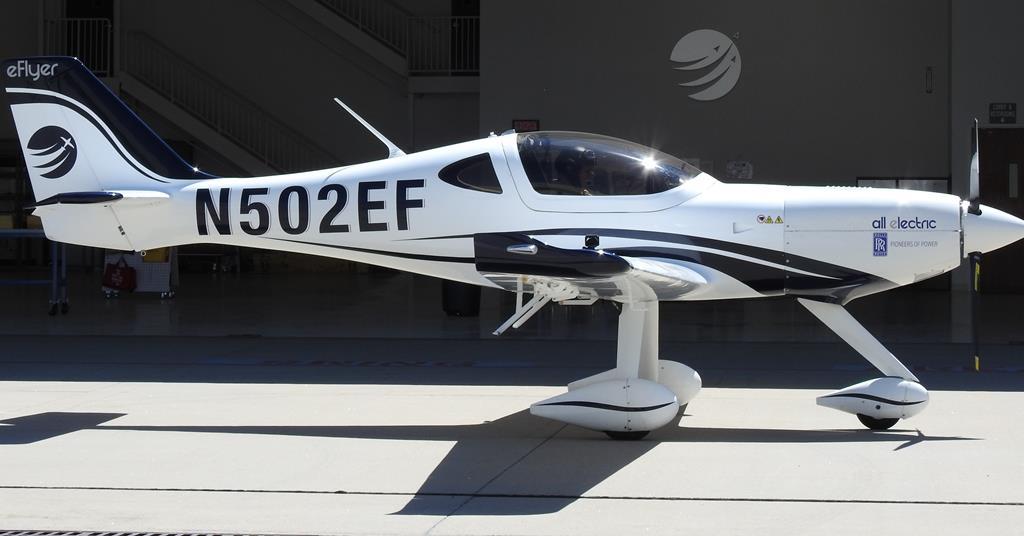
Bye begins propeller testing for all-electric eFlyer 2
Bye Aerospace has begun the next phase of flight testing on its eFlyer 2 technology demonstrator, which the US company says will help it select the most efficient propeller to maximise the performance of the all-electric aircraft.www.flightglobal.com
By Kate Sarsfield23 June 2020
Bye Aerospace has begun the next phase of flight testing on its eFlyer 2 technology demonstrator, which the US company will use to select the most efficient propeller to maximise the performance of the all-electric aircraft. Flight testing of the proof of concept eFlyer 2 began in April 2018, with the evaluations so far focussed on the aircraft’s design, handling qualities, systems and performance.

Source: Bye Aerospace
Flight testing of the proof of concept eFlyer 2 began in April 2018
The all-composite eFlyer 2 is powered by a 120hp (90kW) Rolls-Royce RRP70D electric motor coupled to a 750V battery system. It delivers speeds of over 135kt (250km/h) and has an endurance of over 3h.
George Bye, chief executive of the Denver, Colorado-headquartered firm, says the latest round of testing will focus on ”collecting flight envelope engineering data” for the three propellers being considered for the production version of eFlyer 2.
The aircraft finished its critical design phase in early June, and Bye will shortly begin assembling the first production-conforming model in preparation for a debut sortie later this year. US certification and service entry of the eFlyer 2 are scheduled for 2021.
Bye will not name the propeller suppliers or products under evaluation, but says the selection will be based on the aerodynamic performance and lightweight design of each system.
“Data from these flight tests will help our engineering team determine the most efficient propeller that will maximise the overall efficiency for the typical flight training syllabus requirement,” says Bye. As well as the flight training market, the eFlyer 2 is targeted at owner-flyers and air taxi operators.
“The Rolls-Royce electric motor on the technology demonstrator has varying torque, and a large RPM range,” says Bye. The forward motor section is also significantly smaller than in aircraft with a conventional engine, leaving more of the blade exposed. This he notes ”leads to increased propulsion efficiency and more torque from the electric motor producing thrust as opposed to cooling air for an internal combustion engine”.
”So we will be conducting flight tests with the various propellers over the summer against these beneficial and unique electric propulsion criteria,” he adds.
Bye expects its eFlyer family - which includes the four-seat eFlyer 4 - to be first Federal Aviation Administration Part 23-certificated, clean-sheet all-electric aircraft.
A four-seater - the eFlyer 4 - is in its preliminary design phase and is scheduled to enter service in 2022. Nearly 350 orders have been secured for the eFlyer pair to date.
Concept design work on a six-to-nine-seat model is also underway, and Bye plans to publically announce the programme later this year.
Поделиться:

